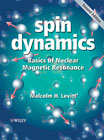
INDICE: Preface. Preface to the First Edition. Introduction. Part 1 NuclearMagnetism. 1 Matter. 1.1 Atoms and Nuclei. 1.2 Spin. 1.3 Nuclei. 1.4 Nuclear Spin. 1.5 Atomic and Molecular Structure. 1.6 States of Matter. Notes. FurtherReading. Exercises. 2 Magnetism. 2.1 The Electromagnetic Field. 2.2 Macroscopic Magnetism. 2.3 Microscopic Magnetism. 2.4 Spin Precession. 2.5 Larmor Frequency. 2.6 Spin-Lattice Relaxation: Nuclear Paramagnetism. 2.7 Transverse Magnetization and Transverse Relaxation. 2.8 NMR Signal. 2.9 Electronic Magnetism. Notes. Further Reading. Exercises. 3 NMR Spectroscopy. 3.1 A Simple Pulse Sequence. 3.2 A Simple Spectrum. 3.4 Relative Spectral Frequencies: Case of Positive Gyromagnetic Ratio. 3.5 Relative Spectral Frequencies: Case of Negative Gyromagnetic Ratio. 3.6 Inhomogeneous Broadening. 3.7 Chemical Shifts. 3.8 J-Coupling Multiplets. 3.9 Heteronuclear Decoupling. Notes. Further Reading. Exercises. Part 2 The NMR Experiment. 4 The NMR Spectrometer. 4.1 The Magnet. 4.2 TheTransmitter Section. 4.3 The Duplexer. 4.4 The Probe. 4.5 The Receiver Section. 4.6 Overview of the Radio-Frequency Section. 4.7 Pulsed Field Gradients. Notes. Further Reading. 5 Fourier Transform NMR. 5.1 A Single-Pulse Experiment. 5.2 Signal Averaging. 5.3 Multiple-Pulse Experiments: Phase Cycling. 5.4 Heteronuclear Experiments. 5.5 Pulsed Field Gradient Sequences. 5.6 Arrayed Experiments. 5.7 NMR Signal. 5.8 NMR Spectrum. 5.9 Two-Dimensional Spectroscopy. 5.10Three-Dimensional Spectroscopy. Part 3 Quantum Mechanics. 6 Mathematical Techniques. 6.1 Functions. 6.2 Operators. 6.3 Eigenfunctions, Eigenvalues and Eigenvectors. 6.4 Diagonalization. 6.5 Exponential Operators. 6.6 Cyclic Commutation. Notes. Further Reading. Exercises. 7 Review of Quantum Mechanics. 7.1 Spinless Quantum Mechanics. 7.2 Energy Levels. 7.3 Natural Units. 7.4 Superposition States and Stationary States. 7.5 Conservation Laws. 7.6 Angular Momentum. 7.7 Spin. 7.8 Spin-1/2. 7.9 Higher Spin. Notes. Further Reading. Exercises. Part 4 Nuclear Spin Interactions. 8 Nuclear Spin Hamiltonian. 8.1 Spin Hamiltonian Hypothesis. 8.2 Electromagnetic Interactions. 8.3 External and Internal SpinInteractions. 8.4 External Magnetic Fields. 8.5 Internal Spin Hamiltonian. 8.6 Motional Averaging. Notes. Further Reading. Exercises. 9 Internal Spin Interactions. 9.1 Chemical Shift. 9.2 Electric Quadrupole Coupling. 9.3 Direct Dipole-Dipole Coupling. 9.4 J-Coupling. 9.5 Spin-Rotation Interaction. 9.6 Summaryof the Spin Hamiltonian Terms. Notes. Further Reading. Exercises. Part 5 Uncoupled Spins. 10 Single Spin-1/2. 10.1 Zeeman Eigenstates. 10.2 Measurement of Angular Momentum: Quantum Indeterminacy. 10.3 Energy Levels. 10.4 Superposition States. 10.5 Spin Precession. 10.6 Rotating Frame. 10.7 Precession in the Rotating Frame. 10.8 Radio-Frequency Pulse. Notes. Further Reading. Exercises. 11 Ensemble of Spins-1/2. 11.1 Spin Density Operator. 11.2 Populations and Coherences. 11.3 Thermal Equilibrium. 11.4 Rotating-Frame Density Operator. 11.5 Magnetization Vector. 11.6 Strong Radio-Frequency Pulse. 11.7 Free Precession Without Relaxation. 11.8 Operator Transformations. 11.9 Free Evolution with Relaxation. 11.10 Magnetization Vector Trajectories. 11.11 NMR Signal and NMR Spectrum. 11.12 Single-Pulse Spectra. Notes. Further Reading. Exercises. 12 Experiments on Non-Interacting Spins-1/2. 12.1 Inversion Recovery: Measurement of T1. 12.2 Spin Echoes: Measurement of T2. 12.3 Spin Locking: Measurement of T1Æ.12.4 Gradient Echoes. 12.5 Slice Selection. 12.6 NMR Imaging. Notes. Further Reading. Exercises. 13 Quadrupolar Nuclei. 13.1 Spin I = 1. 13.2 Spin I = 3/2.13.3 Spin I = 5/2. 13.4 Spins I = 7/2. 13.5 Spins I = 9/2. Notes. Further Reading. Exercises. Part 6 Coupled Spins. 14 Spin-1/2 Pairs. 14.1 Coupling Regimes. 14.2 Zeeman Product States and Superposition States. 14.3 Spin-Pair Hamiltonian. 14.4 Pairs of Magnetically Equivalent Spins. 14.5 Weakly Coupled Spin Pairs. Notes. Further Reading. Exercises. 15 Homonuclear AX System. 15.1 Eigenstates and Energy Levels. 15.2 Density Operator. 15.3 Rotating Frame. 15.4 Free Evolution. 15.5 Spectrum of the AX System: Spin-Spin Splitting. 15.6 Product Operators. 15.7 Thermal Equilibrium. 15.8 Radio-Frequency Pulses. 15.9 Free Evolution of the Product Operators. 15.10 Spin Echo Sandwich. Notes. Further Reading. Exercises. 16 Experiments on AX Systems. 16.1 COSY. 16.2 INADEQUATE. 16.3INEPT. 16.4 Residual Dipolar Couplings. Notes. Further Reading. Exercises. 17Many-Spin Systems. 17.1 Molecular Spin System. 17.2 Spin Ensemble. 17.3 Motionally Suppressed J-Couplings. 17.4 Chemical Equivalence. 17.5 Magnetic Equivalence. 17.6 Weak Coupling. 17.7 Heteronuclear Spin Systems. 17.8 Alphabet Notation. 17.9 Spin Coupling Topologies. Notes. Further Reading. Exercises. 18 Many-Spin Dynamics. 18.1 Spin Hamiltonian. 18.2 Energy Eigenstates. 18.3 Superposition States. 18.4 Spin Density Operator. 18.5 Populations and Coherences. 18.6NMR Spectra. 18.7 Many-Spin Product Operators. 18.8 Thermal Equilibrium. 18.9Radio-Frequency Pulses. 18.10 Free Precession. 18.11 Spin Echo Sandwiches. 18.12 INEPT in an I2S System. 18.13 COSY in Multiple-Spin Systems. 18.14 TOCSY. Notes. Further Reading Exercises. Part 7 Motion and Relaxation. 19 Motion. 19.1 Motional Processes. 19.2 Motional Time-Scales. 19.3 Motional Effects. 19.4 Motional Averaging. 19.5 Motional Lineshapes and Two-Site Exchange. 19.6 SampleSpinning. 19.7 Longitudinal Magnetization Exchange. 19.8 Diffusion. Notes. Further Reading. Exercises. 20 Relaxation. 20.1 Types of Relaxation. 20.2 Relaxation Mechanisms. 20.3 Random Field Relaxation. 20.4 Dipole-Dipole Relaxation. 20.5 Steady-State Nuclear Overhauser Effect. 20.6 NOESY. 20.7 ROESY. 20.8 Cross-Correlated Relaxation. Notes. Further Reading. Exercises. Appendices. Appendix A. A.1 Euler Angles and Frame Transformations. A.2 Rotations and Cyclic Commutation. A.3 Rotation Sandwiches. A.4 Spin-1/2 Rotation Operators. A.5 Quadrature Detection and Spin Coherences. A.6 Secular Approximation. A.7 QuadrupolarInteraction. A.8 Strong Coupling. A.9 J-Couplings and Magnetic Equivalence. A.10 Spin Echo Sandwiches. A.11 Phase Cycling. A.12 Coherence Selection by Pulsed Field Gradients. A.13 Bloch Equations. A.14 Chemical Exchange. A.15 SolomonEquations. A.16 Cross-Relaxation Dynamics. Notes. Further Reading. Appendix B. B.1 Symbols and Abbreviations. B.2 Answers to the Exercises.
- ISBN: 978-0-470-51117-6
- Editorial: John Wiley & Sons
- Encuadernacion: Rústica
- Páginas: 736
- Fecha Publicación: 15/02/2008
- Nº Volúmenes: 1
- Idioma: Inglés
